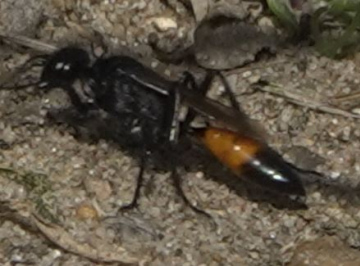Species Account for Podalonia affinis
Podalonia affinis (Kirby, 1798)
Mud Wasp
Aculeata: Sphecidae

Reproduction for study and non-profit use permitted, all other rights reserved.
Taxonomic group: bees and wasps (Aculeata) - County data
View time series maps for Podalonia affinis
member log-on for taxon report
Status: RDB 3
Essex RDB: Listed
Threat: Essex Vulnerable
Images
upload a new image
Species text
This large black and red solitary sand wasp has a strangely patchy distribution which includes parts of south-east England and several northerly vice-counties of England. East Anglia seems to be the British stronghold of this species. It is a very scarce species with its modern strongholds in the Brecks, Suffolk Sandlings and sandy coastal districts of East Anglia. About 25 post-1970 sites are known, from fifteen 10km squares. Records refer fairly equally to both coastal and inland sites. The wasp occurs in a variety of open, sandy situations are inhabited, including coastal dunes and heathland. The adult female locates and paralyses larvae of tussock and soil-dwelling noctuid moths such as Agrostis. The female usually excavates the nest burrow before hunting. Usually one caterpillar is deposited in each nest, rarely two. Adults may visit flowers such as Eryngium for nectar. The distribution of P. affinis suggests that it may be more thermophilic than the more widely distributed P. hirsuta (which does not occur in Essex), although they co-exist at some sites (Falk 1991b). P.R.Harvey 2007. References
Habitats
Recorded management for locations with Podalonia affinis
Recorded substrate and hydrology for locations with Podalonia affinis
Why not join the Club, register and add a new species page
Interpretation of distribution maps
























